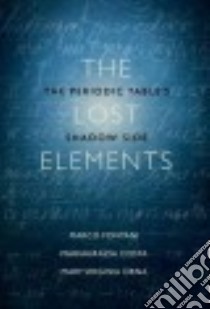- Libreria
- >
- Libri in lingua
- >
- Matematica e scienze
- >
- Storia delle scienze
The Lost Elements - 9780199383344
Un libro in lingua di Marco Fontani Mariagrazia Costa Orna Mary Virginia edito da Oxford Univ Pr on Demand, 2014
- € 44.90
- Il prezzo è variabile in funzione del cambio della valuta d’origine
In the mid-nineteenth century, chemists came to the conclusion that elements should be organized by their atomic weights. However, the atomic weights of various elements were calculated erroneously, and chemists also observed some anomalies in the properties of other elements. Over time, it became clear that the periodic table as currently comprised contained gaps, missing elements that had yet to be discovered. A rush to discover these missing pieces followed, and a seemingly endless amount of elemental discoveries were proclaimed and brought into laboratories. It wasn't until the discovery of the atomic number in 1913 that chemists were able to begin making sense of what did and what did not belong on the periodic table, but even then, the discovery of radioactivity convoluted the definition of an element further. Throughout its formation, the periodic table has seen false entries, good-faith errors, retractions, and dead ends; in fact, there have been more elemental "discoveries" that have proven false than there are current elements on the table.
The Lost Elements: The Shadow Side of Discovery collects the most notable of these instances, stretching from the nineteenth century to the present. The book tells the story of how scientists have come to understand elements, by discussing the failed theories and false discoveries that shaped the path of scientific progress. Chapters range from early chemists' stubborn refusal to disregard alchemy as legitimate practice, to the effects of the atomic number on discovery, to the switch in influence from chemists to physicists, as elements began to be artificially created in the twentieth century. Along the way, Fontani, Costa, and Orna introduce us to the key figures in the development of the periodic table as we know it. And we learn, in the end, that this development was shaped by errors and gaffs as much as by correct assumptions and scientific conclusions.
Informazioni bibliografiche
- Titolo del Libro in lingua: The Lost Elements
- Sottotitolo: The Periodic Table's Shadow Side
- Lingua: English
- Autori : Marco Fontani Mariagrazia Costa Orna Mary Virginia
- Editore: Oxford Univ Pr on Demand
- Collana: Oxford Univ Pr on Demand (Hardcover)
- Data di Pubblicazione: 03 Novembre '14
- Genere: SCIENCE
- Argomenti : Chemical elements Chemical elements History Periodic law History
- Pagine: 531
- ISBN-10: 0199383340
- EAN-13: 9780199383344


